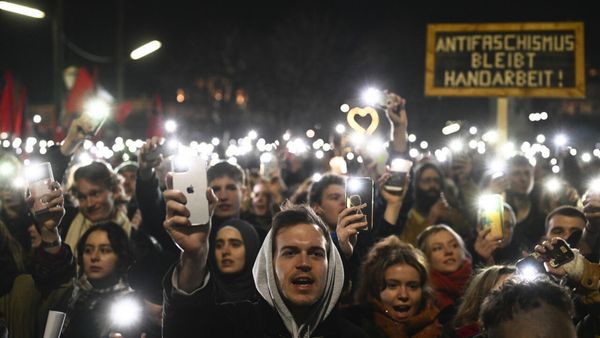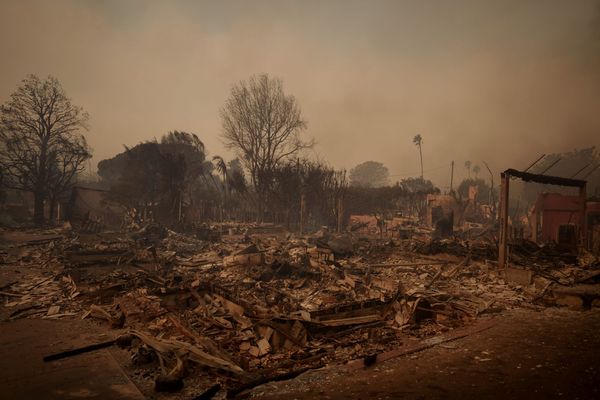
On December 17, in the immediate aftermath of Typhoon Rai, also called Typhoon Odette, President Rodrigo Duterte announced the government was trying to raise funds because the pandemic had left state coffers “depleted.” The next day, Duterte conducted an aerial inspection of the affected provinces.
Duterte’s aide and ally, Senator Christopher “Bong” Go, was with him during the inspection and pledged that “the whole government is here to help and fulfill its duties.” In a statement, the pair promised two billion Philippine pesos funneled through government agencies for food, medicine, and rescue efforts.
But on December 21, Duterte repeated his claim that the state’s resources were depleted.
The following day, the Department of Budget and Management (DBM) explained this confusing series of announcements. They clarified that ₱2 billion (US$40 million) will indeed be allotted for typhoon related relief and rehabilitation through the Calamity Fund. Another ₱2 billion will come from the President’s Contingency Fund. And then another ₱6 billion (US$120 million) will follow once Duterte signs off on the national budget for 2022. A total of ₱4 billion (US$80 million) of readily available reserves is to be released immediately. The rest of the ₱10 billion (US$200 million) pledge will be released indefinitely, presumably once Duterte approves and fast-tracks the nation’s spending.
“The lack of urgency is appalling,” said Katrina Stuart-Santiago, founder of the People for Accountable Governance and Sustainable Action or PAGASA (Hope).
“The first Duterte soundbite about this typhoon was about how there were no more government funds for relief and rehab efforts because all of it had been used for the pandemic. And yet Duterte has billions in confidential and intelligence funds under the Office of the President — funds that he has refused to account for. This is the thing with refusing transparency: you cannot say you don’t have money, if you’re not telling us where you’re spending it.”

Stuart-Santiago said that quite a few agencies and ongoing government programs are enjoying the generous budget allocations because they are more of a priority to the administration than relief efforts from the typhoon.
There is approximately ₱9.6 billion (US$192 million) left in the Calamity Fund. The DBM, however, has issued statements indicating that it does not want to use all these funds in one outlay.
But this is all to say nothing of the vast resources the state expends on fighting its domestic campaigns against its own people. There is ₱8.6 billion (US$172 million) available in intelligence funds. The National Task Force to End the Local Communist Armed Conflict or NTF-ELCAC which the state uses to weed out its political rivals and eliminate critics of the regime enjoys ₱19.2 billion (US$384 million).
Moreover, the Philippines has borrowed around US$4.55 billion since the pandemic began from international financial institutions. The sum of the loans is roughly 50 times the country’s annual budget. If Duterte says that all the money’s gone, he implies that all of these funds are unavailable less than two years after they’ve been received.
“So really, when Duterte says the government has no money, we all know it’s a complete lie. It’s really that he isn’t spending these funds — not to mention all the loans — to serve citizens in an efficient, competent way, in a time of multiple crises,” explained Santiago.
‘Disaster Pork’
Lia Mai, the Executive Director of the Center for Environmental Concerns, said that the funds designated for disaster relief are especially vulnerable to misuse. “The reality is that the government will always be out of disaster relief funds because of systematic government corruption and neglect. The nature of what has been characterized as ‘disaster pork’ or discretionary lump sums at the mercy of the state’s cronies are vulnerable year-round to misuse by officials.”
Mai continued, “These are the same Quick Response and Calamity funds which the state is taking its time distributing. Even the ₱1 -billion People’s Survival Fund meant to finance local climate adaptation adaptation projects are inaccessible and usually reverted back to un-programmed funds that can be rechanneled discretionary budget by the official’s prerogative.”
The typhoon has caused 400 deaths and billions of dollars of damage to land, property, and the livelihoods of millions of Filipinos. The UN Refugee Agency estimates 1.8 million people have been affected with nearly 800,000 displaced. Aside from the mismanagement in expenditures, Mitzi Jonelle Tan, of the group Youth Advocates for Climate Action Philippines (YACAP) condemned the chronically underprepared Philippine government.
Tan said, “Despite scientists identifying Odette a few days before, there was still a lack of proactive preparation and communication with the communities. People had nowhere to evacuate in some areas because the designated evacuation centers are churches, schools, and gyms, not actual buildings built to be evacuation centers. As civil society and people’s organizations were quick to act and come together to help each other out, the national government as a whole and local government units in some areas failed to prioritize the people most marginalized and to take quick action both before and after the typhoon.”

Earlier this year, Environment Secretary Roy Cimatu revealed that 130 of the 142 critical watersheds in the country are badly in need of rehabilitation and protection. Lia Mai, the Executive Director of the Center for Environmental Concerns, said poor preparation is a chronic problem of the state’s environmental efforts. “It shouldn’t be a surprise that the regions afflicted by Odette could not mitigate the extreme rainfall and flooding cause.”
Mai also emphasized the information deficit that the government is partially responsible for causing. In the first few days of the typhoon’s wake, much of the nation was in the dark about the degree of destruction it wrought. “With the Duterte government’s closure of the ABS-CBN media network, which had the broadest presence reaching even the most remote interior municipalities, has definitely affected the communications infrastructure. Situation reports are coming in trickles.”
According to Santiago, “There is no sense or proof that there are actual funds being funneled to these areas.” It’s been more than a week. For those affected, it looks the two weeks leading up to Christmas will be spent without food and shelter.
Filipino activists are broadly in agreement that the Duterte administration has the money. They also believe that the government is making a political calculation to prioritize the regime’s cronies and the security state over the needs of the people.
READ NEXT: How a Community Pantry Sparked Movement of Mutual Aid in the Philippines
TNL Editor: Nicholas Haggerty (@thenewslensintl)
If you enjoyed this article and want to receive more story updates in your news feed, please be sure to follow our Facebook.







